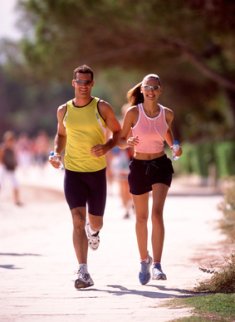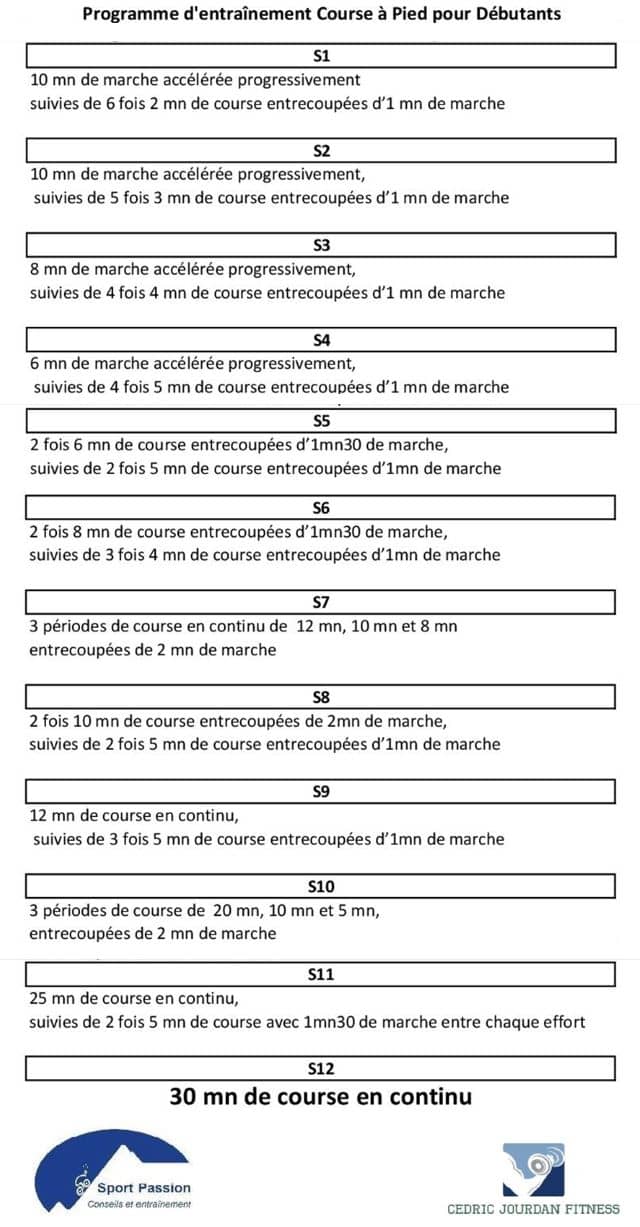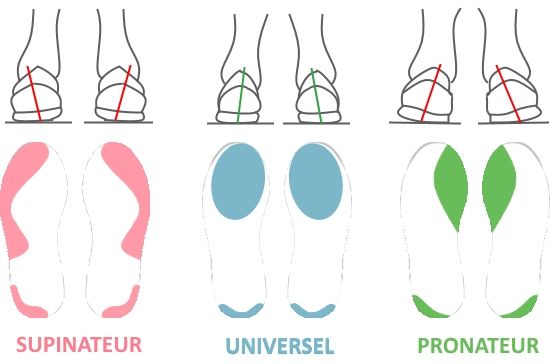- Error #1: running in poorly adapted running shoes
- Error #2: always run on the same running surface
- Error #3: Breathing poorly
- Error #4: Be careful with overtraining
- Error #5: wanting to run too fast
- Error #6: Being afraid of... walking
- Error #7: neglect the warm-up and the return to calm
- Error #8: thinking that fasting is magic
- Error #9: Eat just before training
- Error #10: underestimate your lifestyle
Error #1: running in poorly adapted running shoes
Do you have a pronunciation, supination or universal stride? Shoes are a highly important piece of equipment for runners. To make your choice, price is the first criterion, often followed by the design of the shoe. Above all, however, it is important to know your stride to find the right shoe for you.
It is estimated that there are approximately 55 % of people with a universal stride, 35 % of pronators and 10 % of supinators.
To find out, you can analyse the wear and tear of your old shoes (see diagram below). A pronounced stride mainly wears out the inner part, while the opposite is true for the supinator stride, which will damage the outer edge of the forefoot. Finally, the universal or neutral stride wears out the central part. This is due to the position of the foot during the race.
If you are a beginner, buying these shoes on the internet may not be the best solution. In a sports store, you can talk to specialized salespeople to get advice on the type of shoe that is best suited to your goal and stride. Finally, a visit to a sports podiatrist is not insignificant when running to see together the usefulness of orthopaedic inserts designed to control the arch of the foot (1).
Error #2: always run on the same running surface
It is estimated that about 13.5 million French people run (2). It must be said that the constraints are minimal. You put on your sneakers and go running near your home for 10 minutes, 30 minutes or 1 hour depending on the time you have. The Union Sport & Cycle study also questioned the practitioners at the place of practice. In this respect, it is worth remembering that varying the running surfaces reduces the risk of injury. You have a lot of choice:
- Asphalt or bitumen
- The forest
- The synthetic tartan track
- The sand
- The grass
- The treadmills
Forest roads are the most popular among practitioners, followed by asphalt. Each surface has its own set of advantages and disadvantages. While tartan provides a pleasant cushioning for a smooth recovery, motivation can still take a hit when you run 1 hour around a 400m track. Asphalt, thanks to its hard ground, allows maximum propulsion but is harmful to joints. Forest roads are interesting to work on your ownership and benefit from a good cushioning. Soft sand will significantly increase the difficulty of effort but may increase the risk of tendonitis. Finally, the Treadmill is ideal in winter or bad weather but the sensations will not be comparable to running outside.
The perfect surface does not exist. The ideal is to vary your playgrounds according to the type of training but also according to your desires.
Error #3: Breathing poorly
Breathing seems simplistic in everyday life. However, during a race, the problem gets worse. Your mission if you accept it is to breathe in to let oxygen into the lungs and then exhale to evacuate carbon dioxide while producing an effort. One problem: it will change the way you breathe. Through the nose? Through the mouth? In several stages? When you start out, it is not easy to find the right breathing and side stitches occur quickly, damaging the diaphragm, the main respiratory muscle.
When running, breathing is linked to your sensations and running speed. Generally, the inhalation is done through the nose and then completed by the mouth while the exhalation is done through the mouth. The objective is to find your own breathing rhythm, which must be natural and increasingly unconscious, automated. When you start, strides can be a support point for your breathing. For example, breathe in three strides to breathe out three strides.
Error #4: Be careful with overtraining
You've decided to start running and you're fully motivated! It's all to your credit, but beware of overtraining. In concrete terms, this is a training volume that exceeds your recovery capacity. Whether you are a beginner or experienced, everyone can be touched. However, if you were sedentary and have recently started running, be doubly vigilant with this change of pace. Running involves all muscle groups and more broadly all the body's functions. Generally, we recommend 24 to 48 hours of rest after your training. This allows you to train 3 times a week on average. However, the desire to progress, from losing weight or being ready for a competition can lead you to increase your usual training frequency or volume. This is how the signs of overtraining appear. These can include chronic fatigue, difficulty falling asleep, lack of appetite, mood disorders, muscle aches and pains or reduced performance.
We recommend that you allow yourself enough rest periods. This includes a restful sleep, naps if necessary, a peri-training diet rich in carbohydrates and proteins as well as a hydration sufficient. I mean, there's no need to compare yourself to others. Depending on your lifestyle (rest, work, diet, family life), you can train intensively 4 times a week and be overtrained while your colleague runs 7 days a week and shows no signs.
Error #5: wanting to run too fast

A recent study(3) involving 5048 people for more than 10 years showed that running too fast was not beneficial on his life expectancy. It is therefore not necessary to push back your limits at each session to improve your health... quite the contrary.
Running is an attractive and exhilarating activity. Who has never thought "I'm going for a little jog" to finish 50 minutes later in a sprint giving it all away. Sport secretes endorphins that sometimes put us on a cloud and give us good sensations.
As a beginner, progression must be sought. However, it is not only reflected in the stopwatch. An improvement in pace, breathing and posture are all positive signs that will inevitably lead to an improvement in your performance. Wanting to run faster and faster with each training session significantly increases the risk of injury.
According to some studies, 2 to 3 training sessions per week at a moderate intensity would be the perfect cocktail to increase your life expectancy by an average of 6 years.
Error #6: Being afraid of... walking
Walking during training is not a sign of weakness. If you are a beginner, we encourage you to alternate between running and walking phases. This will allow an active, highly beneficial recovery.
Discover our running training program for beginners. During 12 sessions, you will alternate running and walking phases to succeed in running for 30 minutes without stopping.

Error #7: neglect the warm-up and the return to calm
In running, as elsewhere, the warm-up phase is important to avoid injury and improve performance. The same goes for the calm phase, which prepares for the upcoming recovery. Therefore, we are thinking of doing some active-dynamic stretching as well as a progressive intensity jogging for 15 minutes before his session. At the end of the training, we avoid the famous final sprint and we can proceed to some stretching. As we recalled in a previous article on warming up, "our tendons, our body and our nervous system perform at their best at a temperature of 39°C". It is therefore advisable to increase your warm-up in the morning or in cold weather for example in order to put your body in the best conditions to face the upcoming training.
This article may be of interest to you: Sports warm-up: preparing effectively
Error #8: thinking that fasting is magic
For 27% of novice runners, weight loss or body contour improvement is their primary motivation. However, the desire to go run on an empty stomach could trot you to a corner of your head to accelerate fat loss.
According to the scientific studies (4) (5), opinions differ. Some say that running on an empty stomach is not significant on weight loss while others show an additional caloric expenditure of 20 %.
In case of doubt, it is advisable to make up your own mind without expecting miraculous effects. Weight loss must be a long-term process and running on an empty stomach must be done episodically. The risk of injuries on a cold organism and the risk of hypoglycemia are very real.
If you support fasting sports, it is therefore possible to try it once a week or every two weeks by going gradually. Of course, intense sessions are avoided. It will be a jog by increasing the duration of the race week after week. For the first time, you can run 15 minutes on an empty stomach and then save 5 minutes each week without exceeding 1 h of practice.
If running on an empty stomach is not your cup of tea, don't worry, it is quite possible to achieve your goal without using this training method.
Also to be read: Sport on an empty stomach, benefits and dangers, what you need to know
Error #9: Eat just before training
In theory, it is recommended to eat 3 hours before your running session, especially during competitions. In practice, it is not always easy to meet this deadline. As a beginner, just remember that your digestion should not affect your running session. Nothing is more unpleasant than feeling bloated during your run. To avoid it, it is advisable to eat digestible foods, say at least 30 minutes before the session. A banana, oatmeal, cottage cheese and lemon water will make up a balanced breakfast. Also pay attention to quantities. If you run in the morning, it may be better to split your breakfast in two to avoid having your stomach too full during your outing.
Error #10: underestimate your lifestyle
For once, sport and food are inseparable. Here, we go further by talking about healthy living. Thus, it is necessary, as much as possible, to have an irreproachable lifestyle. We think of the phases of sleep, recovery, alcohol, smoking, stress and of course food. 1 hour of moderate speed running would save us 7 h more life expectancy according to an American study (6). To do this, it is important to put all the chances on your side by limiting alcohol, tobacco and all factors harmful to your health and performance as much as possible. Running is a sport where healthy living is a priority. Every superfluous kilogram is immediately felt on his stopwatch but especially on his joints.
In conclusion
By following our 10 tips, you will put all the chances on your side to practice running in the best conditions. The sooner you integrate these mistakes to avoid, the better your progress and the better your goal will be achieved.
References:(1) Effect of soles during running (Stéphane Vermand, 2016)
(2) The practitioners under the microscope
These articles may also interest you
Photo credit : Adobe Stock. This article contains commercial links.









